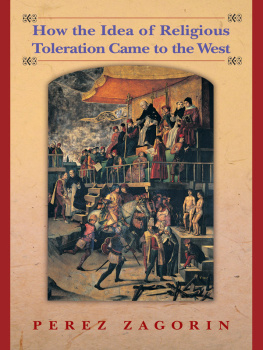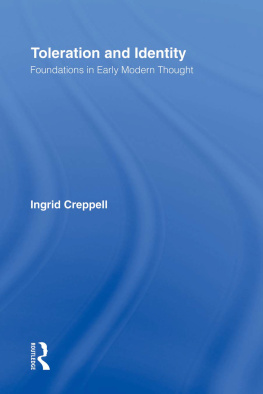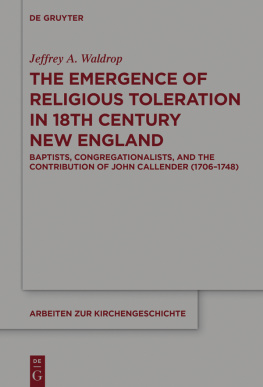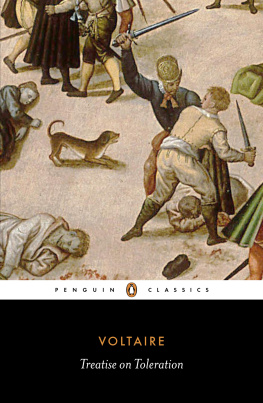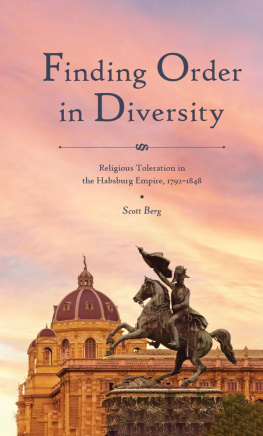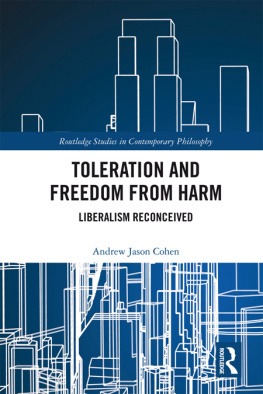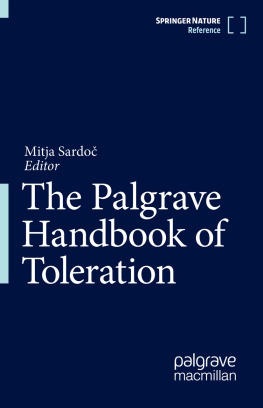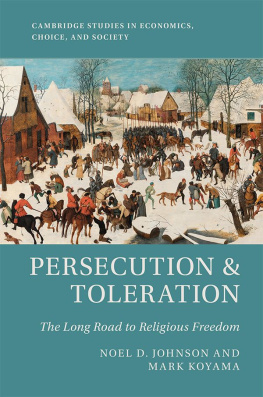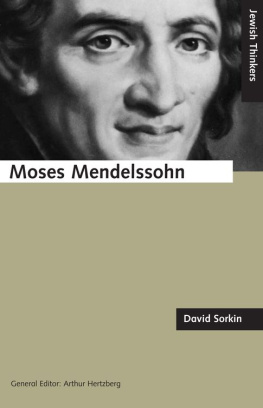Zagorin - How the Idea of Religious Toleration Came to the West
Here you can read online Zagorin - How the Idea of Religious Toleration Came to the West full text of the book (entire story) in english for free. Download pdf and epub, get meaning, cover and reviews about this ebook. year: 2013, publisher: Princeton University Press, genre: Religion. Description of the work, (preface) as well as reviews are available. Best literature library LitArk.com created for fans of good reading and offers a wide selection of genres:
Romance novel
Science fiction
Adventure
Detective
Science
History
Home and family
Prose
Art
Politics
Computer
Non-fiction
Religion
Business
Children
Humor
Choose a favorite category and find really read worthwhile books. Enjoy immersion in the world of imagination, feel the emotions of the characters or learn something new for yourself, make an fascinating discovery.
How the Idea of Religious Toleration Came to the West: summary, description and annotation
We offer to read an annotation, description, summary or preface (depends on what the author of the book "How the Idea of Religious Toleration Came to the West" wrote himself). If you haven't found the necessary information about the book — write in the comments, we will try to find it.
Zagorin: author's other books
Who wrote How the Idea of Religious Toleration Came to the West? Find out the surname, the name of the author of the book and a list of all author's works by series.
How the Idea of Religious Toleration Came to the West — read online for free the complete book (whole text) full work
Below is the text of the book, divided by pages. System saving the place of the last page read, allows you to conveniently read the book "How the Idea of Religious Toleration Came to the West" online for free, without having to search again every time where you left off. Put a bookmark, and you can go to the page where you finished reading at any time.
Font size:
Interval:
Bookmark:

How the Idea of Religious Toleration Came to the West

How the Idea of Religious Toleration Came to the West

PEREZ ZAGORIN
Princeton University Press Princeton and Oxford
Copyright 2003 by Princeton University Press
Published by Princeton University Press, 41 William Street, Princeton, New Jersey 08540
In the United Kingdom: Princeton University Press, 6 Oxford Street, Woodstock, Oxfordshire OX20 1TW
All Rights Reserved
Fifth printing, and first paperback printing, 2006
Paperback ISBN: 978-0-691-12142-0
The Library of Congress has cataloged the cloth edition of this book as follows
Zagorin, Perez.
How the idea of religious toleration came to the West / Peter Zagorin.
p. cm.
Includes bibliographical references (p.) and index.
ISBN 0-691-09270-2 (alk. paper)
1. Religious toleranceChristianityHistory. I. Title.
BR1610 .Z34 2003
261.7209dc21 2002042565
British Library Cataloging-in-Publication Data is available
This book has been composed in New Baskerville
Printed on acid-free paper.
press.princeton.edu
Printed in the United States of America
7 9 10 8 6
THIS BOOK IS DEDICATED TO MY WIFE,
Honor Sharrer,
WITH LOVE AND GRATITUDE FOR OVER FIFTY YEARS OF MARRIED HAPPINESS AND INTELLECTUAL COMPANIONSHIP.


God is always on the side of the persecuted. If a just man is persecuted by a wicked one, God is with the persecuted just man. If a wicked man is persecuted by a wicked man, God is with the persecuted. And if a wicked man is persecuted by a just man, God is on the side of the persecuted wicked man against the persecutor.
The Talmud
To kill a man is not to defend a doctrine, it is to kill a man. When the Genevans killed Servetus, they did not defend a doctrine, they killed a man.
Sebastian Castellio, Contra libellum Calvini
After a careful investigation into the meaning of the term heretic, I can discover no more than this, that we regard those as heretics with whom we disagree.
Sebastian Castellio, De haereticis
It is accordingly on this battlefield [of religion], almost solely, that the rights of the individual against society have been asserted on broad grounds of principle, and the claim of society to exercise authority over dissentients openly controverted. The great writers to whom the world owes what liberty it possesses, have most asserted freedom of conscience as an indefeasible right, and denied absolutely that a human being is accountable to another for his religious belief.
John Stuart Mill, On Liberty
PREFACE

I n August 1790 the Hebrew Congregation of Newport, Rhode Island, sent an address of praise and congratulations to President George Washington on the occasion of his visit to Newport. Speaking in the name of the children of the stock of Abraham, it voiced gratitude for a government erected by the Majesty of the People which to bigotry gives no sanction, to persecution no assistance, but generously affords to everyone liberty of conscience, and immunities of citizenship. Washingtons cordial letter of reply, which thanked the congregation, also confirmed its sentiments, extolling the Citizens of the United States for having given to mankind examples of an enlarged and liberal policy worthy of imitation in which all people enjoyed the exercise of their inherent natural rights, including liberty of conscience.
This noteworthy exchange between the Hebrew Congregation of Newport and the first president of the United States is even more memorable because Washington directed his remarks to Jewish citizens, members of a religious community that had been oppressed and persecuted by the Christian world for many centuries. His words may be taken as an eloquent testimony to the central importance religious toleration and the free exercise of religion have held among American values since the founding of the United States. The Bill of Rights, which became part of the United States Constitution in the following year, 1791, prohibits Congress from establishing any state religion, thereby forbidding the introduction of any government-imposed barrier to religious pluralism. Needless to say, Americans have not always lived up to the ideal of religious freedom that the founders of the United States professed. The past two centuries of American history contain numerous examples of episodes and entrenched institutional policies reflecting animosity and systematic discrimination, bigotry, and exclusion directed against Catholics, Jews, and other religious minorities. In spite of this, however, it is also true that most of the American people have never ceased to regard freedom of religion as one of their basic and most precious rights. Today, following our recent entrance into the new millennium and the deadly attack on the United States by Islamic terrorists on 11 September 2001, we cherish this right more than ever as an essential attribute of a free society.
But how and where did the concept of religious tolerance and freedom originate? In the United States, to the extent that Americans may think about this question at all, they are most likely to look for the answer in the writings of the American founders like Thomas Jefferson and James Madison, and in the United States Constitution with its provisions for the toleration of religious differences and the protection of religious freedom. The founders thoughts on this subject were largely derivative, however, and a product of the European Enlightenment of the eighteenth century and of what came before. The rationale of religious toleration and the theological, moral, and philosophical justification of religious freedom had their real beginning in the sixteenth century; they were forged in the bitter denominational conflicts, the continued struggle against persecution, and the fierce intellectual controversies arising out of the religious divisions created in Europe by the Protestant Reformation.
The modern concepts of religious toleration and freedom are thus Western in origin and the offspring of European civilization. They are almost entirely due (the main exception is the Jewish philosopher Spinoza) to the work of Christian thinkers, mostly unorthodox Protestants, of the sixteenth and seventeenth centuries, all of whom were powerfully motivated by their religious beliefs to fight against the intolerance of both the Catholic and Protestant churches. It is very true that expressions and values of tolerance, respect for other faiths, and religious coexistence can be found in the teachings of other world religions such as Judaism, Islam, Hinduism, and Buddhism, even though fanaticism and religious hatreds on the part of members of these religions, past and present, have often belied such teachings. It is only in Western society, nevertheless, and only since the sixteenth century because of the conflicts and debates between contending Christian churches, sects, and confessions, that there has appeared a massive body of writings by many different authors exploring the problem of religious toleration from many angles and presenting an array of arguments in behalf of the principles of liberty of conscience, mutual tolerance, and religious coexistence and diversity. This literature was produced at a time when, as in the previous five centuries of Christian history, an accusation of heresy could mean death for the person charged. At its heart, the controversy over religious toleration and liberty of conscience in the sixteenth and seventeenth centuries was a combat against the cruelty of persecution, a refutation of its rationale, and a plea to end the bloodshed and killing among Christians caused by confessional enmity. This controversy played a vital role in the long-term development of religious freedom as one of the distinctive features of contemporary Western civilization.
Next pageFont size:
Interval:
Bookmark:
Similar books «How the Idea of Religious Toleration Came to the West»
Look at similar books to How the Idea of Religious Toleration Came to the West. We have selected literature similar in name and meaning in the hope of providing readers with more options to find new, interesting, not yet read works.
Discussion, reviews of the book How the Idea of Religious Toleration Came to the West and just readers' own opinions. Leave your comments, write what you think about the work, its meaning or the main characters. Specify what exactly you liked and what you didn't like, and why you think so.

